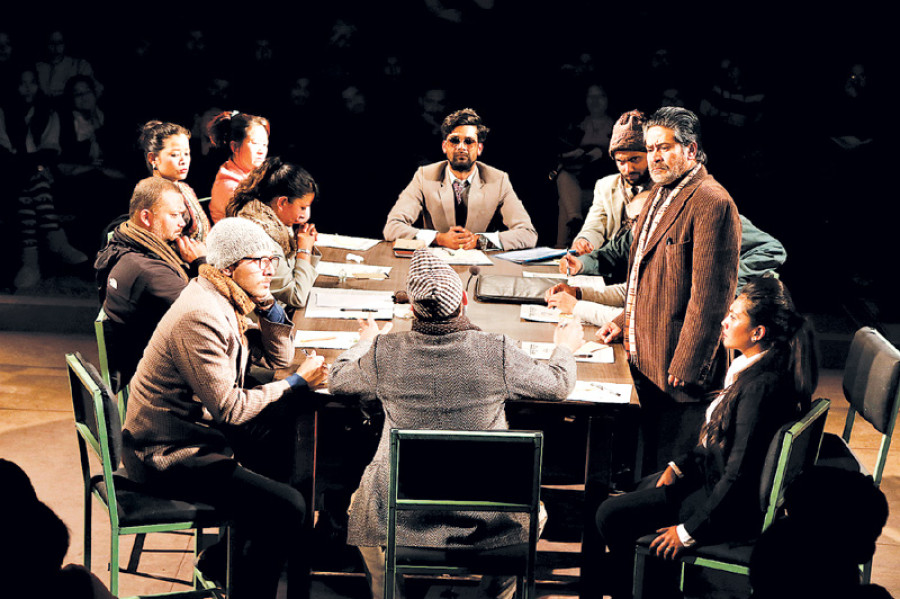Miscellaneous
The age of reason
We are all born unique. That is the very beauty of being human. While that is true, it is also equally natural that we gravitate towards others who are like us—whether that be based of colour, nationality, class, culture or upbringing.
Timothy Aryal
We are all born unique. That is the very beauty of being human. While that is true, it is also equally natural that we gravitate towards others who are like us—whether that be based of colour, nationality, class, culture or upbringing. In turn, it is natural that disputes and feuds arise in a world composed of people of such range and variety. It is what drives the world, what keeps it ticking. One person’s meat is another’s poison; one person’s illusion is another’s reality. This dichotomy is more apparent in the extremely polarised world we live today. This very conflict forms the basis of the play 12 Angry Men—the Nepali adaptation of which, titled Baahra Durvasa, is currently on stage at Mandala Theatre in the Capital. The play, written in 1957 by Reginald Rose, explores human traits, prejudices and rationality and bears testament to how reason and justice should prevail above all else, above personal ego and temporal impulses.

Before we discuss the Nepali adaptation of the play, let us take a brief overview of the original. The play is set almost exclusively in one single setting, where 12 ordinary jurors deliberate upon a homicide. The jurors are put in a rock and hard place as they have to decide whether an 18-year old is guilty of murder; if the men decide he is guilty then he shall be sentenced to death. Obviously, the decision has to be made through unanimity, but is it easy? While the men representing different social hierarchy and class argue for and against each other, presenting their reasons and facts, the play sheds light on the very essence of being human and also on the process of consensus building.
Like anywhere else in the world today, the play resonates across Nepal’s deeply polarised social and political landscape. We blame our political leaders for not being able to reach a consensus, but we oftentimes overlook the long and hard process it really is. Is it easy to form a common opinion over any issue, with people representing such diverse opinions and ideas, with different character traits and rationale?
Baahra Durvasa, which borrows its name from the short-tempered character from the Mahabharata, narrates an event that happens one evening in a private cell where 12 ordinary Nepalis argue over a homicide trial. Not much has been altered from the original text, the essence of the text being carried out in the painstakingly detailed translation by Suresh Sapkota. The dialogues are adapted so as to match the Nepali context and the vernacular; as you watch the play, you’ll find it hard to believe that it is not an original rendition.
Nepal is home to people representing a range of constructed-tribes and cultures. And they are all reflected in the play’s narrative. A Madhesi man with an accent; a differently-abled juror who was once a destitute; women; and an affluent man—all these characters and their unique perspectives come together to give the play inclusivity and also evoke the reality of living in a diverse culture like ours.
There are some rough patches regarding its execution though. Our lead character (played by Pashupati Rai) hardly lives up to the intensity of the play demands. As imagined by the original play, the protagonist is someone who is utterly unsentimental, one who is immersed in reason and rationale, which should thus have been reflected in her delivery and body language. Rai’s protagonist leaves us with a lot to be desired. Maybe, the character would have better suited Srijana Subba, who performed with much vigour.
The play marks a theatrical comeback for veteran actor Saroj Khanal. Khanal, who acted in Nepali cinema for more than three decades, brings his acting skills on to the stage too. Also notable is performances by Somnath Khanal, Srijana Subba, and Badal Bhatta, among others.
Regarding sets, audiences are in for something special. There is no elaborate set, since it is a one-act play and doesn’t need many props. But the design is creative; placed in the middle of the room, with the audience witness from each sides. It evokes a sense that you’re not witnessing a staged drama but a discussion among the jurors in real time; it’s just that real.
The 12 men in 12 Durvasa reach to a conclusion, but the way how they do so is long and winding and also illuminating. Sure, the play has its share of pitfalls regarding its execution, but the motifs it embodies still hits home. It prods one to reflect upon our deeply-polarised society and the long and winding discourse it takes to reach any consensus.




 11.12°C Kathmandu
11.12°C Kathmandu










